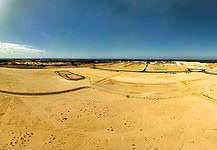Mark Creasy and Galileo Mining managing director Brad Underwood. Image: Galileo Mining.
BY CAMERON DRUMMOND
MARK Creasy-backed Galileo Mining is one of the newest exploration companies to list on the ASX, focused on mining battery metals such as copper, nickel, cobalt, platinum and palladium. Cameron Drummond spoke with managing director Brad Underwood about the company’s drilling plans this year, and his take on WA’s position as a leader in battery minerals production.
Q: What is your professional history?
I have been working as a professional geologist for over 15 years. However, before then I spent some time prospecting for opals and gold and making no money in the process. I realised that a steady pay cheque certainly has its charms.
One of my first real jobs was at the Tritton/Murrawombie copper mine in NSW which was a fantastic learning experience as we had both an open pit and underground mine operating at the same time.
As part of the exploration team, I was able to assist in discovering significant new resources through understanding the geometry of the ore shoots. I believe these resources are still being mined today, which demonstrates the significant impact mining can have on a district given the original discovery was made in 1875.
I also spent some time working in the Pilbara and in the Northern Territory before commencing work with Mark Creasy in 2010.
My most valuable lessons and career experiences have been working with Mark over the last eight years. We have explored for just about every mineral that occurs in hard rock. Most of my work has been in Western Australia with some memorable trips to Myanmar looking for gold and zinc back in the days when Myanmar was a global pariah.
More relevant to Galileo Mining, I was responsible for the exploration and project development of the Creasy tenements in the Fraser Range surrounding the Nova mine which was discovered in 2012.
This area attracted a huge amount of interest at the time, but what is not so well known is that Mark has been spending money in the area since the mid-90s and doesn’t look like stopping anytime soon.
Q: Tell us about your new role at Galileo Mining.
My role as managing director is a fantastic opportunity as it is the first time I have led a publicly listed company. I have been managing privately funded exploration programs for many years and believe that there are plenty of improvements that can be made to the way most junior companies run their exploration programs.
I hope to demonstrate that well thought out exploration strategies can yield success within a reasonable time-frame but I am also very aware that luck is a big factor in our industry.
Q: From a geological point of view, what excites you about Galileo’s Norseman and Fraser Range projects?
The great potential for discovery in WA is what excites me every working day.
I’m not a believer in the idea that we need to go to exotic locations for new discoveries. The jurisdictional risk in some foreign locations is so high that unless a deposit is sticking out of the ground it’s not worth bothering about.
In comparison, WA has excellent infrastructure, a mining culture second to none, and vast areas of underexplored prospective ground.
We have only scratched the surface of our Norseman tenements looking for cobalt and there is additional potential for palladium, platinum and nickel sulfide at depth. Our Fraser Range tenements have never been drilled for nickel simply because the concept that they are prospective for nickel has only developed over the last few years.
Q: After a successful, oversubscribed IPO and ASX listing, what will be Galileo’s first moves?
Galileo plans to start diamond drilling in late June for metallurgical samples from our cobalt deposit. We have designed a comprehensive work program to include mineralogy, beneficiation and leaching test work on the core.
Each ore deposit is unique and we want to develop a detailed understanding of our resource at a very early stage as this preliminary work will guide us towards the completion of a scoping study.
In July we plan to start drilling aimed at boosting our resource base with several new targets already identified as well as possible resource extensions. Our Mt Thirsty resource is open to the north and our Mission Sill resource is open to both the north and the south.
We are optimistic that we can add more tonnes to our resource base by the end of the year.
Q: What are the key drivers behind Galileo’s decision to target nickel, copper and cobalt?
We are big believers in new technology, particularly electric vehicles, and the increasing demand for battery minerals. Over the last five years a number of new lithium mines have opened in the State and, with nickel miners now talking about the production of nickel and cobalt sulphate, it looks like WA is set to become a globally significant player in battery minerals.
We want to be a part of the new battery mineral development cycle and we believe that we have the assets to make it happen.
Q: Final thoughts?
In 1900, horses were the dominant means of transport and within 20 years the combustion engine had taken over.
It would be a mistake to think that similar step-changing technological revolutions are not capable of occurring again, given that we have the very recent examples of computing and smart phones.
The ability of humans to adapt and take on new technology is amazing. I think that in 10 years we will all be driving electric vehicles as if we had been doing it our entire lives.






































